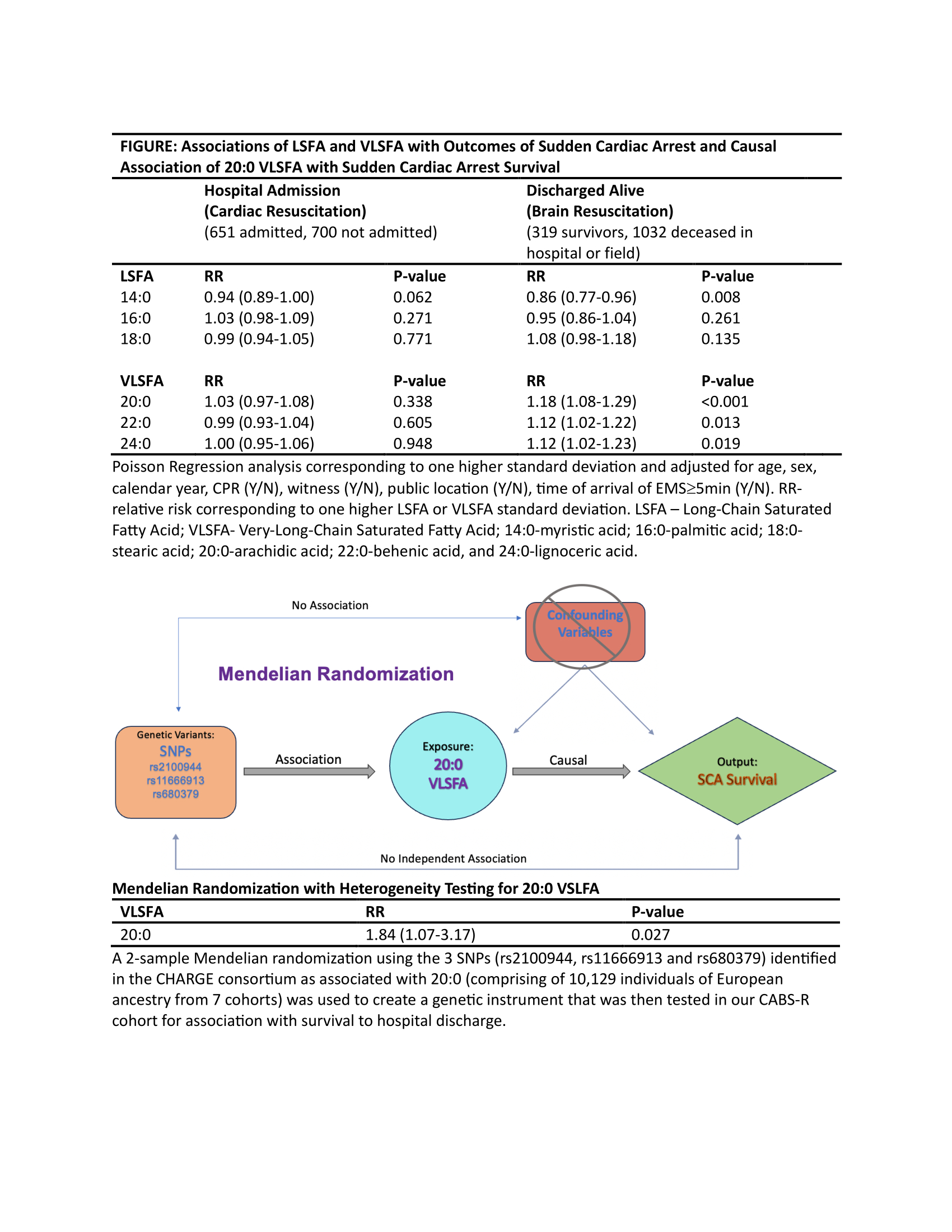Final ID: 046
Associations of Long-Chain and Very-Long-Chain Saturated Fatty Acids with Outcomes of Sudden Cardiac Arrest
Abstract Body: Background: Sudden cardiac arrest (SCA) due to ventricular fibrillation (VF) is a leading cause of mortality. Circulating fatty acids (FA) are influenced by diet and metabolism and have been linked to sudden cardiac arrest (SCA) risk. Certain long-chain saturated fatty acids (LSFA, defined as those with 14-18 carbons) and very long-chain saturated fatty acids (VLSFA, with 20+ carbons) have been associated with higher and lower risk of SCA, respectively. We hypothesized that higher LSFA and VLSFA levels would be associated with lower and higher likelihood of survival from SCA, respectively.
Methods: We examined participants from the Cardiac Arrest Blood Study Repository, a study of SCA cases from Washington between 1988 and 2004. Patients were restricted to those with an initial rhythm of VF and who were greater than or equal to 18 years old. Six FA were studied: 3 LSFA (14:0, 16:0, and 18:0) and 3 VLSFA (20:0, 22:0, and 24:0). Poisson regression, adjusted for demographics and health services, was used to assess the association of SCA resuscitation outcomes with FA levels. A 2-sample Mendelian randomization (MR) using the 3 SNPs identified from the CHARGE consortium was conducted to assess causal association between 20:0 VLSFA levels and surviving SCA.
Results: We examined 1351 SCA cases, of whom 700 died in the field, 332 died in the hospital, and 319 survived to hospital discharge. Our predominantly male (80%) cohort had an average age of 67±14 years. In multivariable analyses, higher 14:0 levels were associated with a lower likelihood (risk ratio 0.86, 95% CI: 0.77-0.96, P=0.008) of surviving to hospital discharge. Conversely, higher levels of 20:0, 22:0, and 24:0 were nominally associated with better survival (Figure), with 20:0 remaining significant after accounting for multiple testing (risk ratio 1.18; 95% CI: 1.08-1.29, P<0.001). No FA was associated with likelihood of being admitted to the hospital following SCA. Using MR methodology, we found evidence for a causal association of 20:0. For each standard deviation increase in genetically predicted 20:0 levels there was an 84% (P=0.027) higher likelihood of survival.
Conclusions: Lower levels of 14:0 LSFA and higher levels of 20:0 VLSFA are associated with higher SCA survival. MR analysis suggested that there was a causal relationship of higher 20:0 VLSFA levels with better survival following SCA. Future studies are needed to assess whether administration of 20:0 improve SCA survival.
Methods: We examined participants from the Cardiac Arrest Blood Study Repository, a study of SCA cases from Washington between 1988 and 2004. Patients were restricted to those with an initial rhythm of VF and who were greater than or equal to 18 years old. Six FA were studied: 3 LSFA (14:0, 16:0, and 18:0) and 3 VLSFA (20:0, 22:0, and 24:0). Poisson regression, adjusted for demographics and health services, was used to assess the association of SCA resuscitation outcomes with FA levels. A 2-sample Mendelian randomization (MR) using the 3 SNPs identified from the CHARGE consortium was conducted to assess causal association between 20:0 VLSFA levels and surviving SCA.
Results: We examined 1351 SCA cases, of whom 700 died in the field, 332 died in the hospital, and 319 survived to hospital discharge. Our predominantly male (80%) cohort had an average age of 67±14 years. In multivariable analyses, higher 14:0 levels were associated with a lower likelihood (risk ratio 0.86, 95% CI: 0.77-0.96, P=0.008) of surviving to hospital discharge. Conversely, higher levels of 20:0, 22:0, and 24:0 were nominally associated with better survival (Figure), with 20:0 remaining significant after accounting for multiple testing (risk ratio 1.18; 95% CI: 1.08-1.29, P<0.001). No FA was associated with likelihood of being admitted to the hospital following SCA. Using MR methodology, we found evidence for a causal association of 20:0. For each standard deviation increase in genetically predicted 20:0 levels there was an 84% (P=0.027) higher likelihood of survival.
Conclusions: Lower levels of 14:0 LSFA and higher levels of 20:0 VLSFA are associated with higher SCA survival. MR analysis suggested that there was a causal relationship of higher 20:0 VLSFA levels with better survival following SCA. Future studies are needed to assess whether administration of 20:0 improve SCA survival.
More abstracts on this topic:
Association Between Diet Quality, Hypertension, And Hypertension Awareness Among Adults In Puerto Rico
Tamez Martha, Kaplan Robert, Rodriguez-orengo Jose F, Tucker Katherine, Mattei Josiemer
Atlas of Distal Nephron Mineralocorticoid Receptor-Dependent Transcriptome Reveals Novel Aldosterone ActionsWelling Paul, Jung Hyun Jun, Su Xiao-tong, Kim Boyoung, Alqusairi Lama, Fenton Robert, Ellison David

